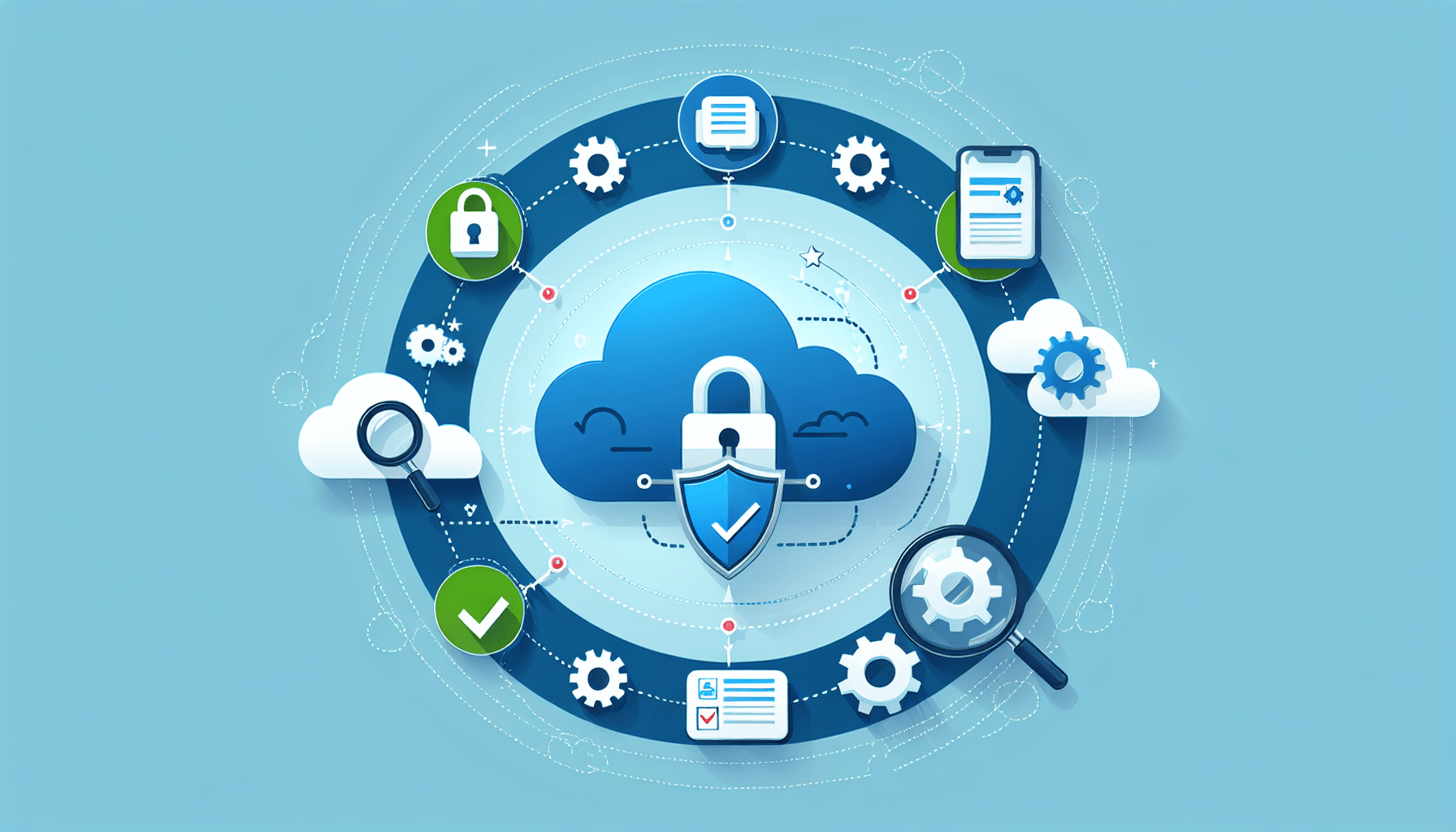Cloud security assessments are a critical aspect of safeguarding your organization’s data and infrastructure in the cloud. In today’s digital landscape, where cloud computing has become an integral part of business operations, it is paramount to understand the scope of these assessments to ensure the protection of sensitive information. This article aims to provide an insightful overview of the various elements involved in cloud security assessments, offering valuable insights into the importance of thorough scrutiny and evaluation. By comprehending the extent of these assessments, you will be better equipped to make informed decisions regarding your cloud security strategy.
Definition of Cloud Security Assessments
Cloud security assessments refer to the evaluation and analysis of security measures and controls implemented within cloud environments. These assessments aim to identify and address potential vulnerabilities, risks, and compliance gaps in order to protect sensitive data, applications, and infrastructure stored and processed in the cloud. By conducting cloud security assessments, organizations can ensure the integrity, confidentiality, and availability of their data and systems, while mitigating the impact of security breaches and unauthorized access.
Overview of Cloud Security Assessments
Cloud security assessments involve a systematic and comprehensive review of the security posture of cloud environments. This includes assessing various aspects such as cloud architecture, security controls, data protection mechanisms, and incident response capabilities. By conducting these assessments, organizations can gain insights into potential security weaknesses and identify areas for improvement in order to enhance the overall security of their cloud infrastructure.
Importance of Cloud Security Assessments
Cloud security assessments play a crucial role in ensuring the security and protection of sensitive data and resources stored in the cloud. As organizations increasingly rely on cloud services for their operations, the need for robust security measures becomes paramount. By performing regular cloud security assessments, organizations can proactively identify and address security vulnerabilities, reduce the risk of data breaches, ensure compliance with regulations, and enhance their overall security posture.

Goals of Cloud Security Assessments
The primary goals of cloud security assessments include:
- Identifying and assessing security risks and vulnerabilities within cloud environments.
- Evaluating the effectiveness of existing security controls and mechanisms.
- Ensuring compliance with relevant security standards and regulations.
- Establishing a proactive approach to security by identifying potential threats and implementing appropriate mitigations.
By achieving these goals, organizations can prevent security incidents, protect critical assets, and maintain trust with their customers.
Types of Cloud Security Assessments
Cloud security assessments can take various forms, depending on the specific objectives and scope of assessment. Some common types of cloud security assessments include:
Risk Assessment
Risk assessments involve identifying and evaluating potential security risks and threats within cloud environments. This includes analyzing factors such as the security of data storage, network configurations, access controls, and third-party integrations. By conducting risk assessments, organizations can identify vulnerabilities and prioritize their efforts to mitigate potential risks.
Vulnerability Assessment
Vulnerability assessments focus on identifying and assessing potential security weaknesses within cloud environments. This involves scanning for known vulnerabilities in cloud infrastructure, applications, and systems. By regularly performing vulnerability assessments, organizations can proactively identify and address vulnerabilities before they are exploited by attackers.
Penetration Testing
Penetration testing, or ethical hacking, involves simulating real-world cyberattacks to test the security defenses of cloud environments. Penetration testers attempt to exploit vulnerabilities in order to gain unauthorized access or compromise systems. By conducting penetration testing, organizations can identify security weaknesses and improve their overall security posture.
Compliance Assessment
Compliance assessments focus on evaluating the adherence of cloud environments to relevant security regulations and standards. This includes assessing compliance with frameworks such as the General Data Protection Regulation (GDPR) or industry-specific standards. By conducting compliance assessments, organizations can ensure they meet legal and regulatory requirements and avoid potential penalties or legal liabilities.
Key Components of Cloud Security Assessments
Cloud security assessments comprise several key components that collectively contribute to a comprehensive evaluation of the security posture of cloud environments. These components include:
Cloud Architecture Review
A cloud architecture review involves assessing the design and implementation of cloud infrastructure, including networks, servers, storage, and virtualization. This ensures that the cloud architecture aligns with best practices and industry standards and that potential security risks are identified and mitigated.
Security Controls Evaluation
Evaluating security controls involves assessing the effectiveness of existing security measures and mechanisms within the cloud environment. This includes analyzing access controls, identity and authentication mechanisms, encryption methods, and logging and monitoring practices. By evaluating security controls, organizations can identify gaps and implement necessary improvements.
Data Protection Analysis
Data protection analysis involves assessing the mechanisms in place to protect sensitive data stored and processed in the cloud. This includes evaluating encryption methods, data backup and recovery practices, and data classification and handling procedures. By conducting data protection analysis, organizations can ensure the confidentiality, integrity, and availability of their data.
Incident Response Testing
Incident response testing involves simulating and evaluating an organization’s ability to respond effectively to security incidents within their cloud environment. This includes testing incident response plans, communication procedures, and coordination between various stakeholders. By conducting incident response testing, organizations can identify areas for improvement and enhance their incident response capabilities.

Benefits of Cloud Security Assessments
Cloud security assessments offer several benefits for organizations seeking to enhance the security of their cloud environments. These benefits include:
Improved Security Posture
Cloud security assessments help organizations identify and address security vulnerabilities, thereby improving their overall security posture. By conducting these assessments, organizations can implement necessary controls and measures to protect their sensitive data and resources from potential threats.
Identification of Vulnerabilities
Cloud security assessments provide organizations with insights into potential vulnerabilities and weaknesses within their cloud environments. By identifying these vulnerabilities, organizations can proactively address them before they are exploited by malicious actors, thereby reducing the risk of security breaches.
Compliance with Regulations
Cloud security assessments ensure that organizations maintain compliance with relevant security regulations and standards. By conducting regular assessments, organizations can demonstrate their commitment to security and mitigate the risk of non-compliance, which can lead to severe legal and financial consequences.
Risk Mitigation
By identifying and addressing security risks through cloud security assessments, organizations can effectively mitigate potential threats and reduce the likelihood and impact of security incidents. This helps organizations protect their valuable assets, maintain business continuity, and safeguard their reputation and customer trust.
Challenges of Cloud Security Assessments
Despite the benefits, cloud security assessments also present several challenges that organizations need to overcome in order to ensure effective security. These challenges include:
Complexity of Cloud Environments
Cloud environments can be highly complex and dynamic, with multiple layers of infrastructure, services, and interactions. This complexity makes it challenging to assess security effectively, as the assessment needs to cover all components and potential attack vectors within the environment.
Dynamic Nature of Cloud Services
Cloud services evolve and change over time, as new features and functionality are introduced. This dynamic nature makes it difficult to keep up with the latest security requirements and best practices. Organizations need to continuously reassess and update their security measures to adapt to the evolving threat landscape.
Lack of Visibility and Control
Cloud environments often lack the same level of visibility and control as on-premises infrastructure. This can make it challenging to monitor and enforce security measures effectively. Organizations need to rely on cloud service providers for security controls and may have limited visibility into the underlying infrastructure and security mechanisms.
Shared Responsibility Model
Cloud service providers typically follow a shared responsibility model, where they are responsible for the security of the underlying infrastructure, while the organization is responsible for securing their applications and data. This requires organizations to have a clear understanding of their responsibilities and ensure effective coordination with the cloud service provider to address potential security gaps.
Cloud Security Assessment Process
The cloud security assessment process involves several stages, each contributing to a comprehensive evaluation of the security posture of cloud environments. These stages include:
Planning and Scoping
In this stage, organizations define the objectives, scope, and methodology of the cloud security assessment. This involves identifying the assets and resources to be assessed, setting the assessment criteria, and establishing timelines and budgets.
Data Collection and Analysis
This stage involves gathering relevant information and data about the cloud environment, including architecture diagrams, configurations, access controls, and log files. The collected data is then analyzed to identify potential vulnerabilities, risks, and compliance gaps.
Risk Assessment and Prioritization
Based on the data analysis, organizations assess the identified risks and vulnerabilities in terms of their potential impact and likelihood. This helps prioritize the risks and determine the appropriate mitigation measures based on their severity and significance.
Reporting and Recommendations
In this final stage, organizations document the findings, recommendations, and suggested remediation actions resulting from the assessment. The assessment report provides a comprehensive overview of the security posture of the cloud environment and serves as a basis for implementing necessary security improvements.
Best Practices for Cloud Security Assessments
To ensure effective cloud security assessments, organizations should adhere to several best practices. These practices include:
Engage a Qualified Security Assessor
Engaging a qualified security assessor or a third-party security firm with expertise in cloud security assessments can provide valuable insights and ensure an unbiased evaluation. They can bring industry knowledge, experience, and best practices to the assessment process.
Regular Assessments and Updates
Cloud security assessments should be conducted regularly, as the threat landscape evolves and new vulnerabilities emerge. Regular assessments ensure that security measures are up to date, and potential risks and vulnerabilities are addressed in a timely manner.
Implement Security Controls
Organizations should implement robust security controls and mechanisms within their cloud environments to protect against potential threats. This includes deploying firewalls, intrusion detection systems, encryption, and strong access controls. Security controls should be continuously monitored and updated to ensure their effectiveness.
Educate Employees
Employees play a vital role in maintaining the security of cloud environments. Organizations should provide regular training and awareness programs to educate employees about cloud security best practices, potential threats, and the importance of adhering to security policies and procedures. By promoting a culture of security, organizations can enhance the overall security posture and reduce the risk of human error.
Common Cloud Security Threats
Several common threats pose risks to the security of cloud environments. These threats include:
Data Breaches
Data breaches occur when unauthorized individuals gain access to sensitive data stored in the cloud. This can result in the unauthorized disclosure, alteration, or theft of sensitive information, leading to financial loss, reputational damage, and legal liabilities.
Unauthorized Access
Unauthorized access occurs when attackers gain unauthorized access to cloud resources or systems. This can result in the exploitation of vulnerabilities, data breaches, and the compromise of critical infrastructure or applications.
Malware and Ransomware
Malware and ransomware pose a significant threat to cloud environments. Malware can be used to steal data, disrupt operations, or gain unauthorized access. Ransomware, on the other hand, encrypts data and demands a ransom for its release, causing significant disruption and financial loss.
Insider Threats
Insider threats occur when individuals with authorized access misuse their privileges to compromise the security of cloud environments. This can include intentional or unintentional actions that result in data breaches, unauthorized access, or other security incidents.
Tools and Technologies for Cloud Security Assessments
Various tools and technologies can enhance the effectiveness of cloud security assessments. These include:
Cloud Security Platforms
Cloud security platforms provide centralized monitoring and control of security measures within cloud environments. These platforms offer features such as log management, threat detection, vulnerability scanning, and identity and access management.
Vulnerability Scanners
Vulnerability scanners automate the process of identifying potential security vulnerabilities within cloud infrastructure, applications, and systems. These scanners scan for known vulnerabilities and provide reports and recommendations for remediation.
Security Information and Event Management (SIEM)
SIEM tools collect and analyze log data from various sources within the cloud environment, allowing organizations to detect and respond to security incidents in real-time. SIEM platforms provide centralized visibility, alerting, and reporting capabilities, helping organizations maintain control and monitor security events effectively.
Future Trends in Cloud Security Assessments
Cloud security assessments are expected to evolve in response to the changing threat landscape and advancements in technology. Some future trends in cloud security assessments include:
Automation and Artificial Intelligence
Automation and artificial intelligence (AI) will play a crucial role in enhancing the efficiency and effectiveness of cloud security assessments. AI-powered tools can analyze vast amounts of data, detect patterns, and identify potential security risks, helping organizations proactively address vulnerabilities and threats.
Continuous Monitoring and Threat Intelligence
Continuous monitoring and threat intelligence will become increasingly important in cloud security assessments. Organizations will need to implement real-time monitoring solutions that provide constant visibility into their cloud environments and leverage threat intelligence sources to identify emerging threats and new attack vectors.
Integration with DevOps Practices
As organizations embrace DevOps practices, the integration of cloud security assessments into DevOps workflows will become essential. Performing security assessments throughout the development lifecycle will help identify and address security vulnerabilities early on, reducing the risk of introducing security flaws into cloud applications and infrastructure.
In conclusion, cloud security assessments are crucial for organizations seeking to ensure the security, integrity, and availability of their cloud environments. By assessing risks, vulnerabilities, and compliance gaps, organizations can proactively address security weaknesses, protect sensitive data, and mitigate potential threats. By following best practices, utilizing appropriate tools and technologies, and remaining vigilant about emerging threats, organizations can enhance their cloud security posture and maintain the trust of their customers.



